A Long Noncoding RNA ZEB1-AS1 Promotes Tumorigenesis and Predicts Poor Prognosis in Glioma
Abstract
:1. Introduction
2. Results
2.1. Expression of lncRNA ZEB1-AS1 is Up-Regulated in Glioma Tissues
2.2. Relationship of lncRNA ZEB1-AS1 Expression with Clinicopathological Features of Glioma Patients
2.3. High Expression Levels of lncRNA ZEB1-AS1 were Significantly Related to Reduced Overall Survival of Glioma Patients
2.4. lncRNA ZEB1-AS1 Expression was a Potentially Independent Prognostic Marker for Glioma Patients
2.5. siRNA-Induced lncRNA ZEB1-AS1 Silence in U87 and U251 Cells
2.6. Silencing of lncRNA ZEB1-AS1 Inhibited U87 and U251 Cells Proliferation
2.7. Silencing of lncRNA ZEB1-AS1 Promoted U87 and U251 Cells Apoptosis
2.8. Silencing of lncRNA ZEB1-AS1 Inhibited the Migration and Invasion Abilities of U87 and U251 Cell Lines
2.9. Signaling Pathways Relative to Proliferation, Migration, and Invasion of U87 and U251 Cells
3. Discussion
4. Materials and Methods
4.1. Tissue Samples
4.2. Cell Lines and Culture
4.3. Silencing of ZEB1-AS1 by siRNA
4.4. RNA Isolation and Real-Time PCR
4.5. Western Blotting
4.6. Cell Proliferation Assay
4.7. Colony Formation Assay
4.8. Flow Cytometry Analysis of Cell Cycle and Apoptosis
4.9. Wound Healing Assay
4.10. Transwell Invasion Assay
4.11. Statistical Analysis
5. Conclusions
Acknowledgments
Author Contributions
Conflicts of Interest
References
- Sathornsumetee, S.; Rich, J.N. New treatment strategies for malignant gliomas. Expert Rev. Anticancer Ther. 2006, 6, 1087–1104. [Google Scholar] [CrossRef] [PubMed]
- Davis, F.G.; Freels, S.; Grutsch, J.; Barlas, S.; Brem, S. Survival rates in patients with primary malignant brain tumors stratified by patient age and tumor histological type: An analysis based on surveillance, epidemiology, and end results (seer) data, 1973–1991. J. Neurosurg. 1998, 88, 1–10. [Google Scholar] [CrossRef] [PubMed]
- Penas-Prado, M.; Gilbert, M.R. Molecularly targeted therapies for malignant gliomas: Advances and challenges. Expert Rev. Anticancer Ther. 2007, 7, 641–661. [Google Scholar] [CrossRef] [PubMed]
- Van den Bent, M.; Chinot, O.L.; Cairncross, J.G. Recent developments in the molecular characterization and treatment of oligodendroglial tumors. Neuro Oncol. 2003, 5, 128–138. [Google Scholar] [CrossRef] [PubMed]
- Kalpathy-Cramer, J.; Gerstner, E.R.; Emblem, K.E.; Andronesi, O.C.; Rosen, B. Advanced magnetic resonance imaging of the physical processes in human glioblastoma. Cancer Res. 2014, 74, 4622–4637. [Google Scholar] [CrossRef] [PubMed]
- Tsai, M.C.; Spitale, R.C.; Chang, H.Y. Long intergenic noncoding RNAs: New links in cancer progression. Cancer Res. 2011, 71, 3–7. [Google Scholar] [CrossRef] [PubMed]
- Gupta, R.A.; Shah, N.; Wang, K.C.; Kim, J.; Horlings, H.M.; Wong, D.J.; Tsai, M.C.; Hung, T.; Argani, P.; Rinn, J.L.; et al. Long non-coding RNA HOTAIR reprograms chromatin state to promote cancer metastasis. Nature 2010, 464, 1071–1076. [Google Scholar] [CrossRef] [PubMed]
- Li, S.P.; Xu, H.X.; Yu, Y.; He, J.D.; Wang, Z.; Xu, Y.J.; Wang, C.Y.; Zhang, H.M.; Zhang, R.X.; Zhang, J.J.; et al. LncRNA HULC enhances epithelial-mesenchymal transition to promote tumorigenesis and metastasis of hepatocellular carcinoma via the mir-200a-3p/ZEB1 signaling pathway. Oncotarget 2016, 7, 42431–42446. [Google Scholar] [CrossRef] [PubMed]
- Wu, J.; Zhang, J.; Shen, B.; Yin, K.; Xu, J.; Gao, W.; Zhang, L. Long noncoding rna lncTCF7, induced by IL-6/STAT3 transactivation, promotes hepatocellular carcinoma aggressiveness through epithelial-mesenchymal transition. J. Exp. Clin. Cancer Res. CR 2015, 34, 116. [Google Scholar] [CrossRef] [PubMed]
- Li, T.; Xie, J.; Shen, C.; Cheng, D.; Shi, Y.; Wu, Z.; Deng, X.; Chen, H.; Shen, B.; Peng, C.; et al. Amplification of long noncoding RNA ZFAS1 promotes metastasis in hepatocellular carcinoma. Cancer Res. 2015, 75, 3181–3191. [Google Scholar] [CrossRef] [PubMed]
- Shen, L.; Chen, L.; Wang, Y.; Jiang, X.; Xia, H.; Zhuang, Z. Long noncoding RNA MALAT1 promotes brain metastasis by inducing epithelial-mesenchymal transition in lung cancer. J. Neuro Oncol. 2015, 121, 101–108. [Google Scholar] [CrossRef] [PubMed]
- Lv, J.; Qiu, M.; Xia, W.; Liu, C.; Xu, Y.; Wang, J.; Leng, X.; Huang, S.; Zhu, R.; Zhao, M.; et al. High expression of long non-coding RNA SBF2-as1 promotes proliferation in non-small cell lung cancer. J. Exp. Clin. Cancer Res. CR 2016, 35, 75. [Google Scholar] [CrossRef] [PubMed]
- Zequn, N.; Xuemei, Z.; Wei, L.; Zongjuan, M.; Yujie, Z.; Yanli, H.; Yuping, Z.; Xia, M.; Wei, W.; Wenjing, D.; et al. The role and potential mechanisms of lncRNA-TATDN1 on metastasis and invasion of non-small cell lung cancer. Oncotarget 2016, 7, 18219–18228. [Google Scholar] [CrossRef] [PubMed]
- Redis, R.S.; Sieuwerts, A.M.; Look, M.P.; Tudoran, O.; Ivan, C.; Spizzo, R.; Zhang, X.; de Weerd, V.; Shimizu, M.; Ling, H.; et al. CCAT2, a novel long non-coding RNA in breast cancer: Expression study and clinical correlations. Oncotarget 2013, 4, 1748–1762. [Google Scholar] [CrossRef] [PubMed]
- Xu, S.; Wang, P.; You, Z.; Meng, H.; Mu, G.; Bai, X.; Zhang, G.; Zhang, J.; Pang, D. The long non-coding RNA EPB41L4A-AS2 inhibits tumor proliferation and is associated with favorable prognoses in breast cancer and other solid tumors. Oncotarget 2016, 7, 20704–20717. [Google Scholar] [CrossRef] [PubMed]
- Wang, Q.; Zhang, J.; Liu, Y.; Zhang, W.; Zhou, J.; Duan, R.; Pu, P.; Kang, C.; Han, L. A novel cell cycle-associated lncRNA, HOXA11-AS, is transcribed from the 5-prime end of the HOXA transcript and is a biomarker of progression in glioma. Cancer Lett. 2016, 373, 251–259. [Google Scholar] [CrossRef] [PubMed]
- Hu, L.; Lv, Q.L.; Chen, S.H.; Sun, B.; Qu, Q.; Cheng, L.; Guo, Y.; Zhou, H.H.; Fan, L. Up-regulation of long non-coding RNA AB073614 predicts a poor prognosis in patients with glioma. Int. J. Environ. Res. Public Health 2016, 13, 433. [Google Scholar] [CrossRef] [PubMed]
- Qin, X.; Yao, J.; Geng, P.; Fu, X.; Xue, J.; Zhang, Z. LncRNA TSLC1-AS1 is a novel tumor suppressor in glioma. Int. J. Clini. Exp. Pathol. 2014, 7, 3065–3072. [Google Scholar]
- Li, T.; Xie, J.; Shen, C.; Cheng, D.; Shi, Y.; Wu, Z.; Deng, X.; Chen, H.; Shen, B.; Peng, C.; et al. Upregulation of long noncoding RNA ZEB1-AS1 promotes tumor metastasis and predicts poor prognosis in hepatocellular carcinoma. Oncogene 2016, 35, 1575–1584. [Google Scholar] [CrossRef] [PubMed]
- Wang, Y.L.; Bai, Y.; Yao, W.J.; Guo, L.; Wang, Z.M. Expression of long non-coding RNA ZEB1-AS1 in esophageal squamous cell carcinoma and its correlation with tumor progression and patient survival. Int. J. Clin. Exp. Pathol. 2015, 8, 11871–11876. [Google Scholar] [PubMed]
- Fatica, A.; Bozzoni, I. Long non-coding RNAs: New players in cell differentiation and development. Nat. Rev. Genet. 2014, 15, 7–21. [Google Scholar] [CrossRef] [PubMed]
- Geisler, S.; Coller, J. RNA in unexpected places: Long non-coding RNA functions in diverse cellular contexts. Nat. Rev. Mol. Cell Biol. 2013, 14, 699–712. [Google Scholar] [CrossRef] [PubMed]
- Ulitsky, I.; Bartel, D.P. Lincrnas: Genomics, evolution, and mechanisms. Cell 2013, 154, 26–46. [Google Scholar] [CrossRef] [PubMed]
- Sun, X.; Wong, D. Long non-coding RNA-mediated regulation of glucose homeostasis and diabetes. Am. J. Cardiovasc. Dis. 2016, 6, 17–25. [Google Scholar] [PubMed]
- Li, C.P.; Wang, S.H.; Wang, W.Q.; Song, S.G.; Liu, X.M. Long noncoding RNA-SOX2OT knockdown alleviates diabetes mellitus-induced retinal ganglion cell (RGC) injury. Cell. Mol. Neurobiol. 2016, 18. [Google Scholar] [CrossRef] [PubMed]
- Wang, M.; Yao, D.; Wang, S.; Yan, Q.; Lu, W. Long non-coding RNA ensmust00000147869 protects mesangial cells from proliferation and fibrosis induced by diabetic nephropathy. Endocrine 2016. [Google Scholar] [CrossRef] [PubMed]
- Yang, J.H.; Feng, S.D.; Yang, S.S. The role of lncRNA in diabetes and its complications. Sheng Li Ke Xue Jin Zhan Prog. Physiol. 2015, 46, 371–374. [Google Scholar]
- Reddy, M.A.; Chen, Z.; Park, J.T.; Wang, M.; Lanting, L.; Zhang, Q.; Bhatt, K.; Leung, A.; Wu, X.; Putta, S.; et al. Regulation of inflammatory phenotype in macrophages by a diabetes-induced long noncoding RNA. Diabetes 2014, 63, 4249–4261. [Google Scholar] [CrossRef] [PubMed]
- Liu, J.Y.; Yao, J.; Li, X.M.; Song, Y.C.; Wang, X.Q.; Li, Y.J.; Yan, B.; Jiang, Q. Pathogenic role of lncRNA-MALAT1 in endothelial cell dysfunction in diabetes mellitus. Cell Death Dis. 2014, 5, e1506. [Google Scholar] [CrossRef] [PubMed]
- Schmitz, S.U.; Grote, P.; Herrmann, B.G. Mechanisms of long noncoding rna function in development and disease. Cell. Mol. Life Sci. 2016, 73, 2491–2509. [Google Scholar] [CrossRef] [PubMed]
- Dechamethakun, S.; Muramatsu, M. Long noncoding RNA variations in cardiometabolic diseases. J. Hum. Genet. 2016. [Google Scholar] [CrossRef] [PubMed]
- Misawa, A.; Takayama, K.I.; Urano, T.; Inoue, S. Androgen-induced lncRNA SOCS2-AS1 promotes cell growth and inhibits apoptosis in prostate cancer cells. J. Biol. Chem. 2016, 291, 17861–17880. [Google Scholar] [CrossRef] [PubMed]
- Guo, W.; Dong, Z.; Shi, Y.; Liu, S.; Liang, J.; Guo, Y.; Guo, X.; Shen, S.; Shan, B. Aberrant methylation-mediated downregulation of long noncoding RNA loc100130476 correlates with malignant progression of esophageal squamous cell carcinoma. Dig. Liver Dis. 2016, 48, 961–969. [Google Scholar] [CrossRef] [PubMed]
- Zhang, F.; Gao, C.; Ma, X.F.; Peng, X.L.; Zhang, R.X.; Kong, D.X.; Simard, A.R.; Hao, J.W. Expression profile of long noncoding rnas in peripheral blood mononuclear cells from multiple sclerosis patients. CNS Neurosci. Ther. 2016, 22, 298–305. [Google Scholar] [CrossRef] [PubMed]
- Bartonicek, N.; Maag, J.L.; Dinger, M.E. Long noncoding RNAs in cancer: Mechanisms of action and technological advancements. Mol. Cancer 2016, 15, 43. [Google Scholar] [CrossRef] [PubMed]
- Li, J.; Meng, H.; Bai, Y.; Wang, K. Regulation of lncRNA and its role in cancer metastasis. Oncol. Res. 2016, 23, 205–217. [Google Scholar] [CrossRef] [PubMed]
- Schmitt, A.M.; Chang, H.Y. Long noncoding RNAs in cancer pathways. Cancer Cell 2016, 29, 452–463. [Google Scholar] [CrossRef] [PubMed]
- Zhang, C.; Bai, D.S.; Huang, X.Y.; Shi, G.M.; Ke, A.W.; Yang, L.X.; Yang, X.R.; Zhou, J.; Fan, J. Prognostic significance of CAPN4 overexpression in intrahepatic cholangiocarcinoma. PLoS ONE 2013, 8, e54619. [Google Scholar] [CrossRef] [PubMed]
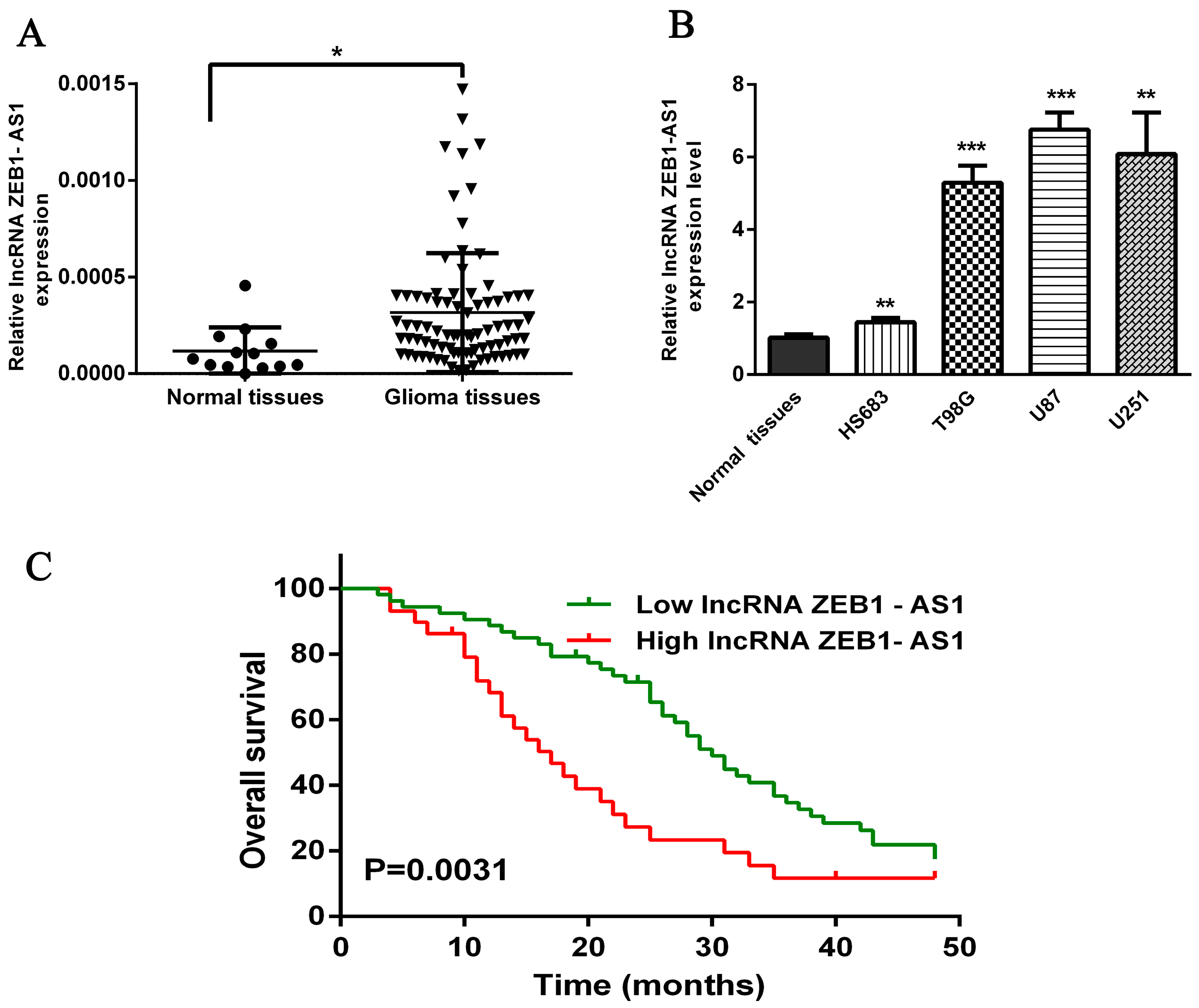


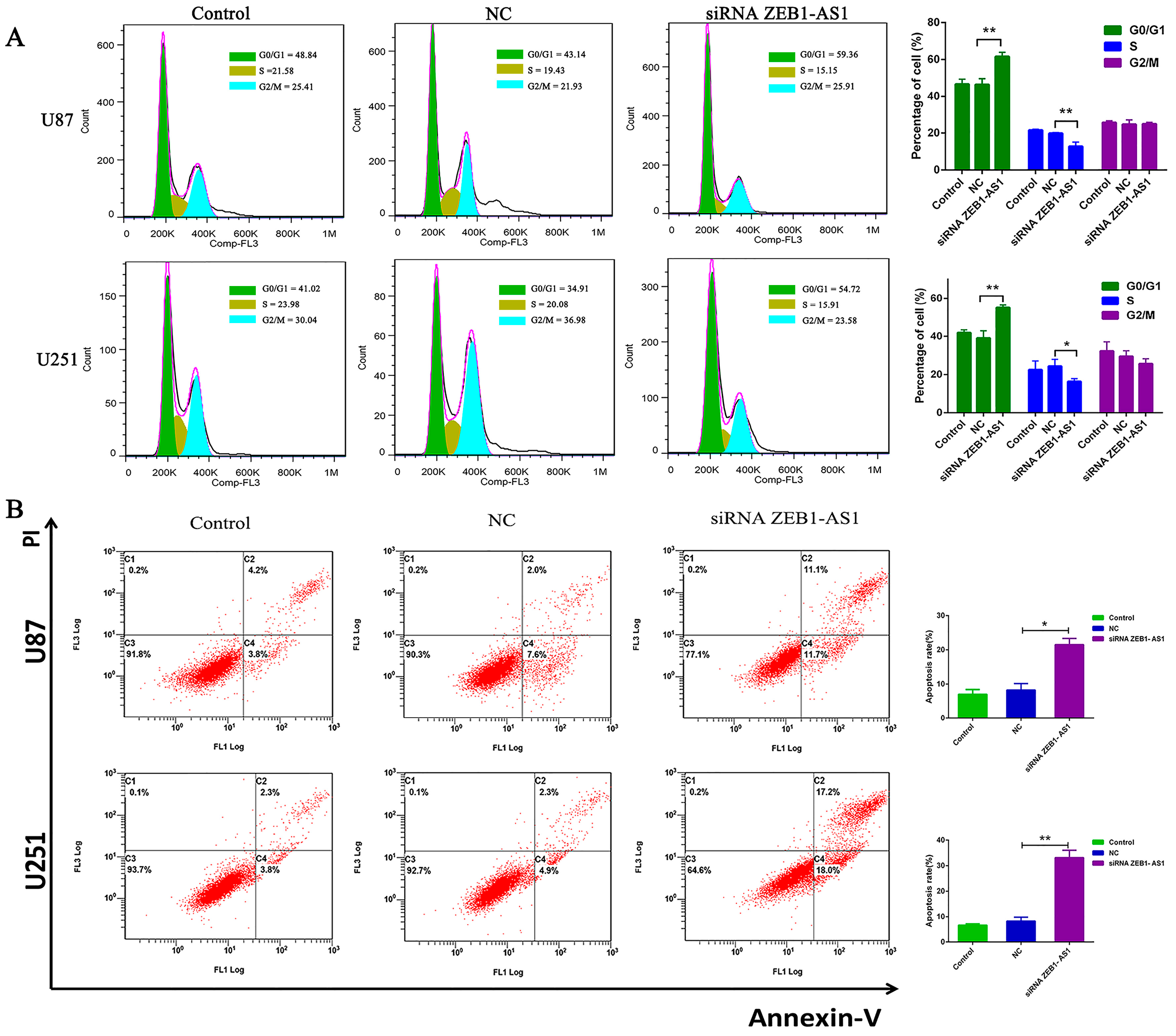
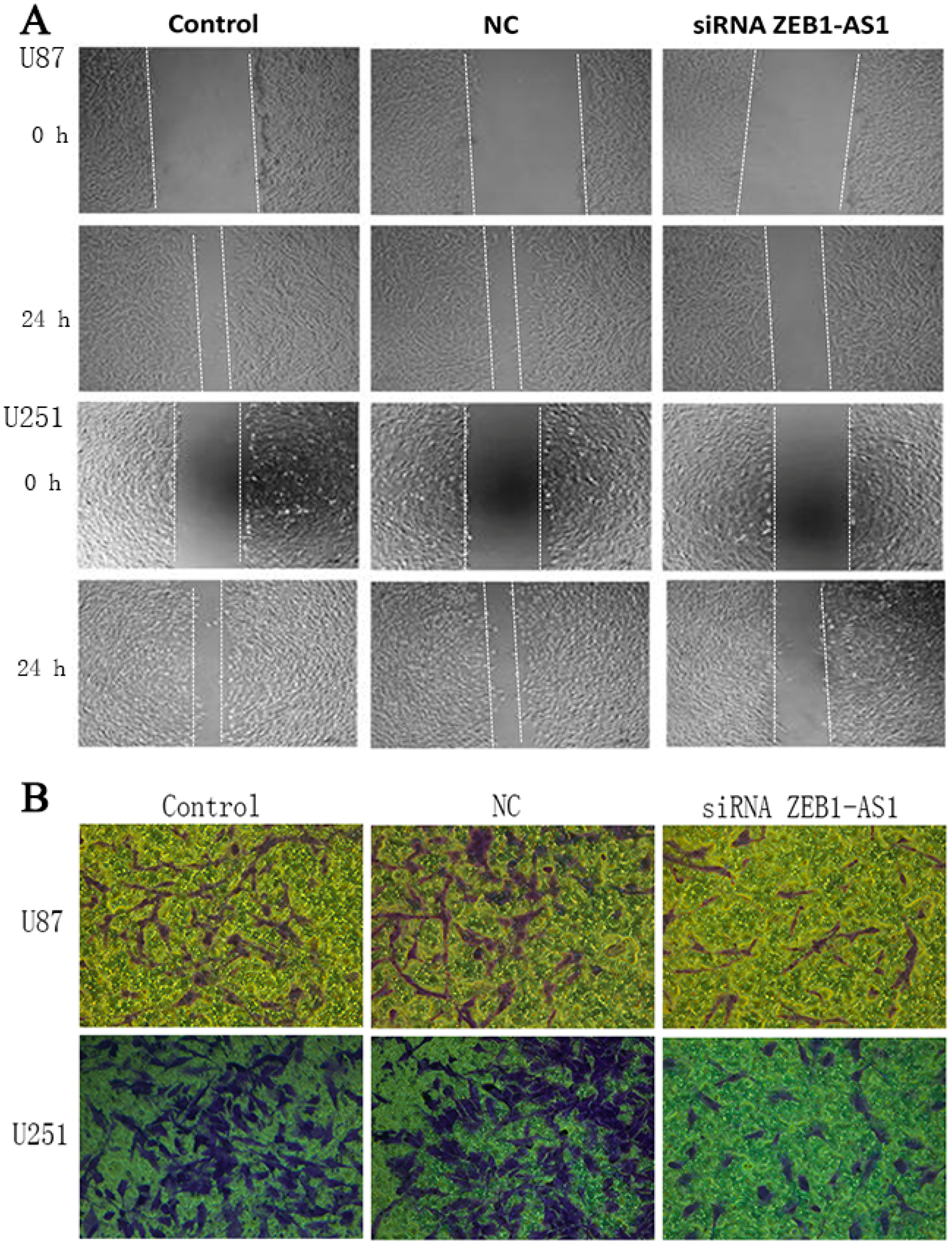
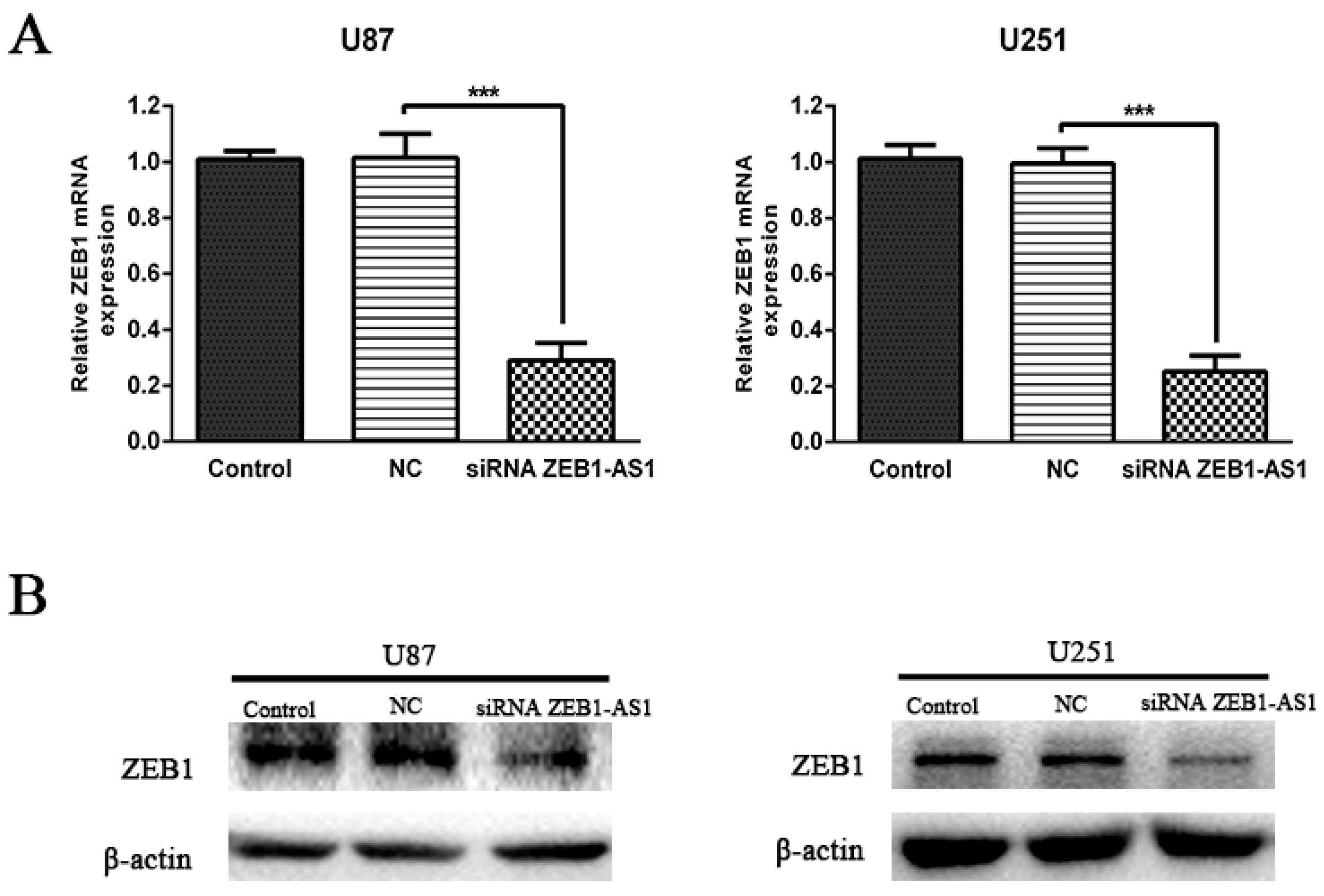
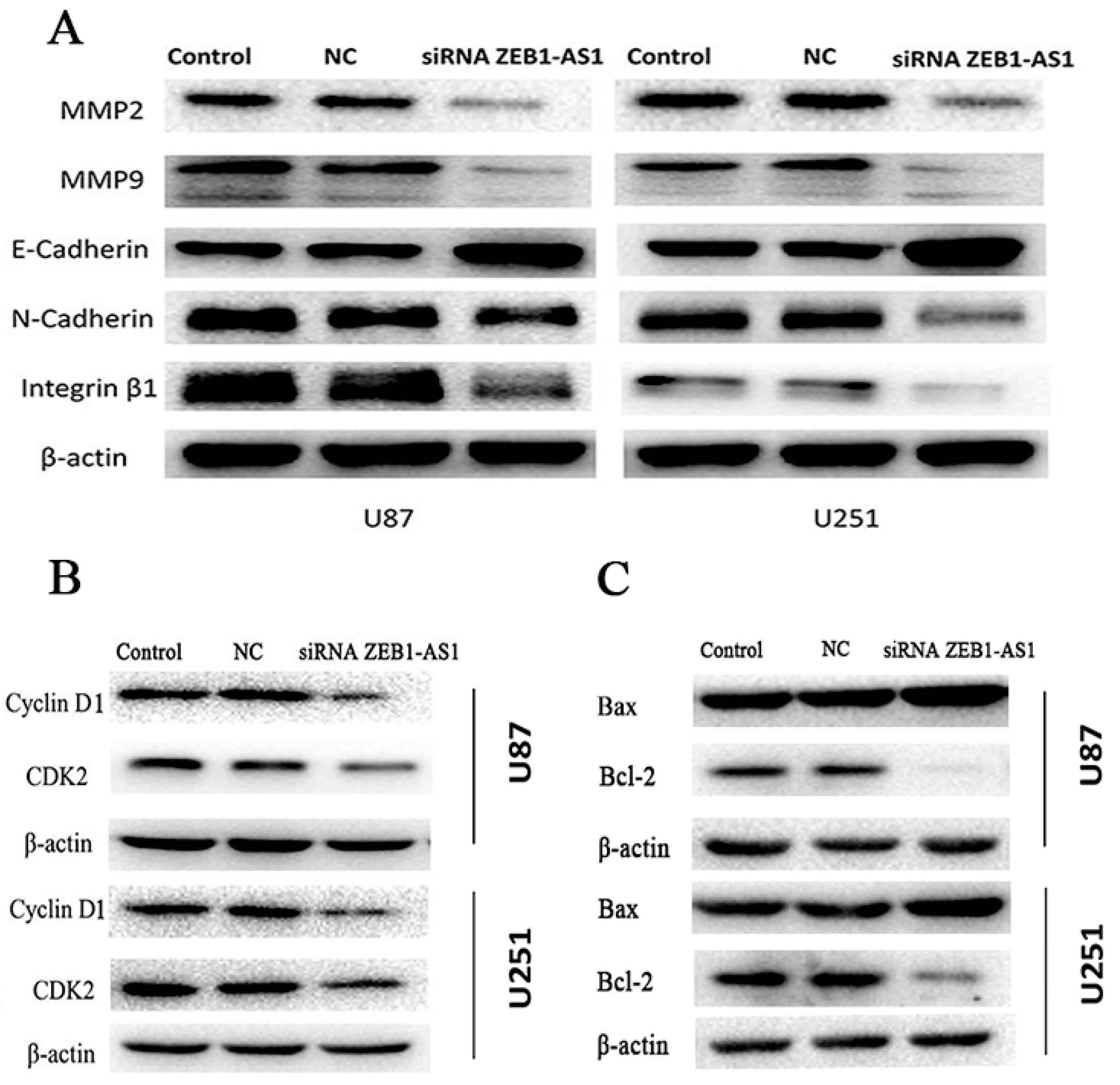
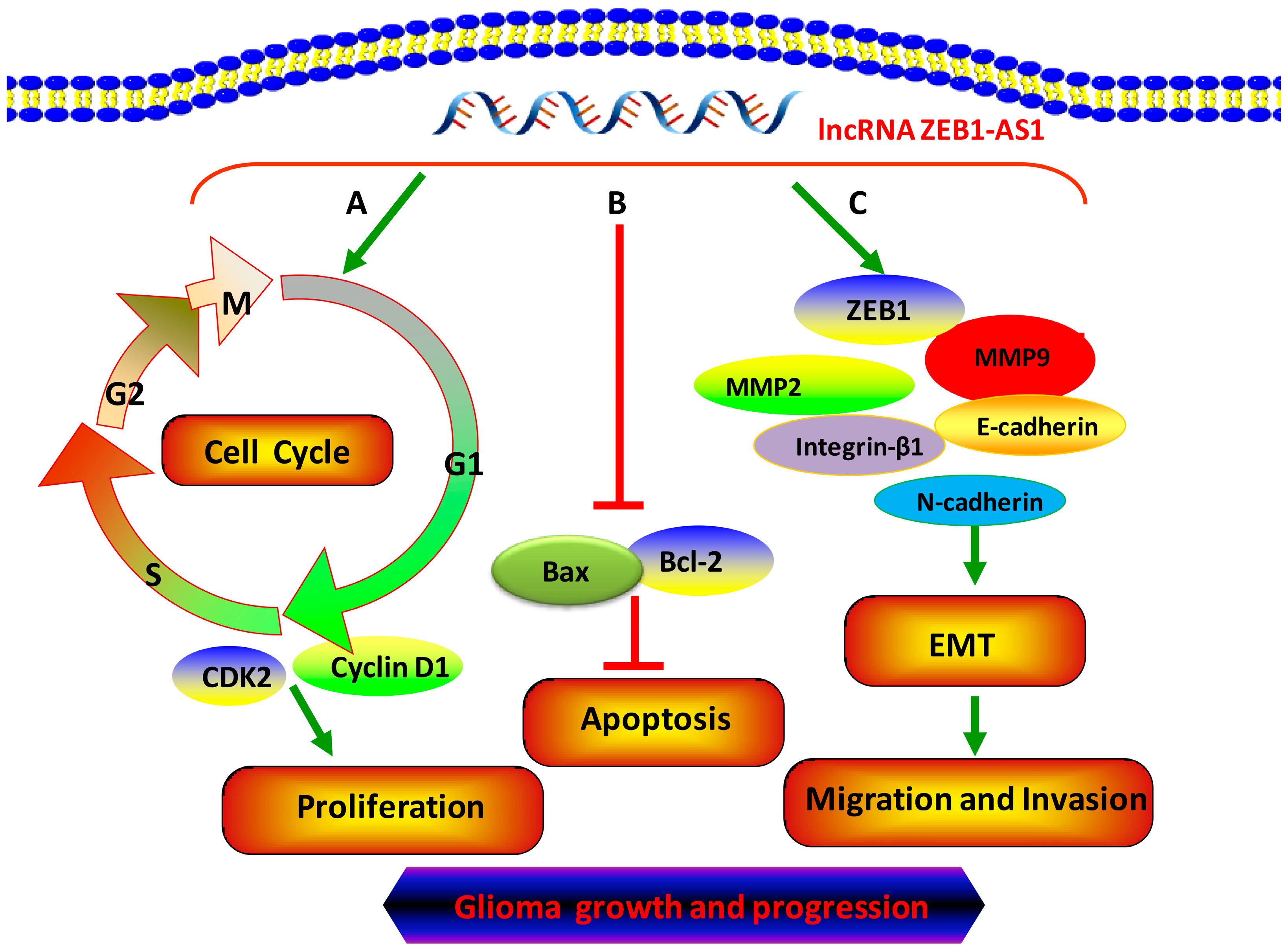
| Clinical Characteristic | No. of Patients | NO. of Patients | p-Value | |
|---|---|---|---|---|
| High Expression (29) | Low Expression (53) | |||
| Age (year) | ||||
| <45 | 35 | 10 | 25 | 0.2668 |
| ≥45 | 47 | 19 | 28 | |
| Sex | ||||
| Male | 52 | 19 | 33 | 0.770 |
| Female | 30 | 10 | 20 | |
| Clinical Stage | ||||
| Low Grades I–II | 37 | 8 | 29 | 0.0183 * |
| High Grades III–IV | 45 | 21 | 24 | |
| Tumor Location | ||||
| Frontal | 26 | 6 | 20 | 0.5170 |
| Parietal | 6 | 2 | 4 | |
| Occipital | 15 | 6 | 9 | |
| Temporal | 14 | 5 | 9 | |
| Others | 21 | 10 | 11 | |
| Variable | Univariate Analysis | p-Value | Multivariate Analysis | p-Value |
|---|---|---|---|---|
| HR (95% CI) | HR (95% CI) | |||
| Age(<45 vs. ≥45 years) | 1.030 (0.631–1.680) | 0.907 | 1.085 (0.599–1.964) | 0.788 |
| Sex (female vs. male) | 1.169 (0.709–1.928) | 0.541 | 1.076 (0.638–1.818) | 0.783 |
| Clinical Stage (III–IV vs. I–II) | 2.141 (1.286–3.563) | 0.003 ** | 1.791 (1.016–3.158) | 0.044 * |
| Tumor Location | 0.636 | 0.848 | ||
| Parietal vs. Frontal | 0.806 (0.275–2.359) | 0.694 | 0.969 (0.308–3.044) | 0.957 |
| Occipital vs. Frontal | 1.117 (0.546–2.287) | 0.762 | 1.080 (0.474–2.461) | 0.855 |
| Temporal vs. Frontal | 1.625 (0.806–3.279) | 0.175 | 1.408 (0.687–2.884) | 0.350 |
| Others vs. Frontal | 1.044 (0.541–2.015) | 0.899 | 0.904 (0.420–1.947) | 0.796 |
| ZEB1-AS1 Expression (high vs. low) | 2.119 (1.265–3.551) | 0.004 ** | 1.885 (1.068–3.326) | 0.029 * |
© 2016 by the authors; licensee MDPI, Basel, Switzerland. This article is an open access article distributed under the terms and conditions of the Creative Commons Attribution (CC-BY) license (http://creativecommons.org/licenses/by/4.0/).
Share and Cite
Lv, Q.-L.; Hu, L.; Chen, S.-H.; Sun, B.; Fu, M.-L.; Qin, C.-Z.; Qu, Q.; Wang, G.-H.; He, C.-J.; Zhou, H.-H. A Long Noncoding RNA ZEB1-AS1 Promotes Tumorigenesis and Predicts Poor Prognosis in Glioma. Int. J. Mol. Sci. 2016, 17, 1431. https://doi.org/10.3390/ijms17091431
Lv Q-L, Hu L, Chen S-H, Sun B, Fu M-L, Qin C-Z, Qu Q, Wang G-H, He C-J, Zhou H-H. A Long Noncoding RNA ZEB1-AS1 Promotes Tumorigenesis and Predicts Poor Prognosis in Glioma. International Journal of Molecular Sciences. 2016; 17(9):1431. https://doi.org/10.3390/ijms17091431
Chicago/Turabian StyleLv, Qiao-Li, Lei Hu, Shu-Hui Chen, Bao Sun, Meng-Long Fu, Chong-Zhen Qin, Qiang Qu, Gui-Hua Wang, Chen-Jie He, and Hong-Hao Zhou. 2016. "A Long Noncoding RNA ZEB1-AS1 Promotes Tumorigenesis and Predicts Poor Prognosis in Glioma" International Journal of Molecular Sciences 17, no. 9: 1431. https://doi.org/10.3390/ijms17091431
APA StyleLv, Q.-L., Hu, L., Chen, S.-H., Sun, B., Fu, M.-L., Qin, C.-Z., Qu, Q., Wang, G.-H., He, C.-J., & Zhou, H.-H. (2016). A Long Noncoding RNA ZEB1-AS1 Promotes Tumorigenesis and Predicts Poor Prognosis in Glioma. International Journal of Molecular Sciences, 17(9), 1431. https://doi.org/10.3390/ijms17091431






